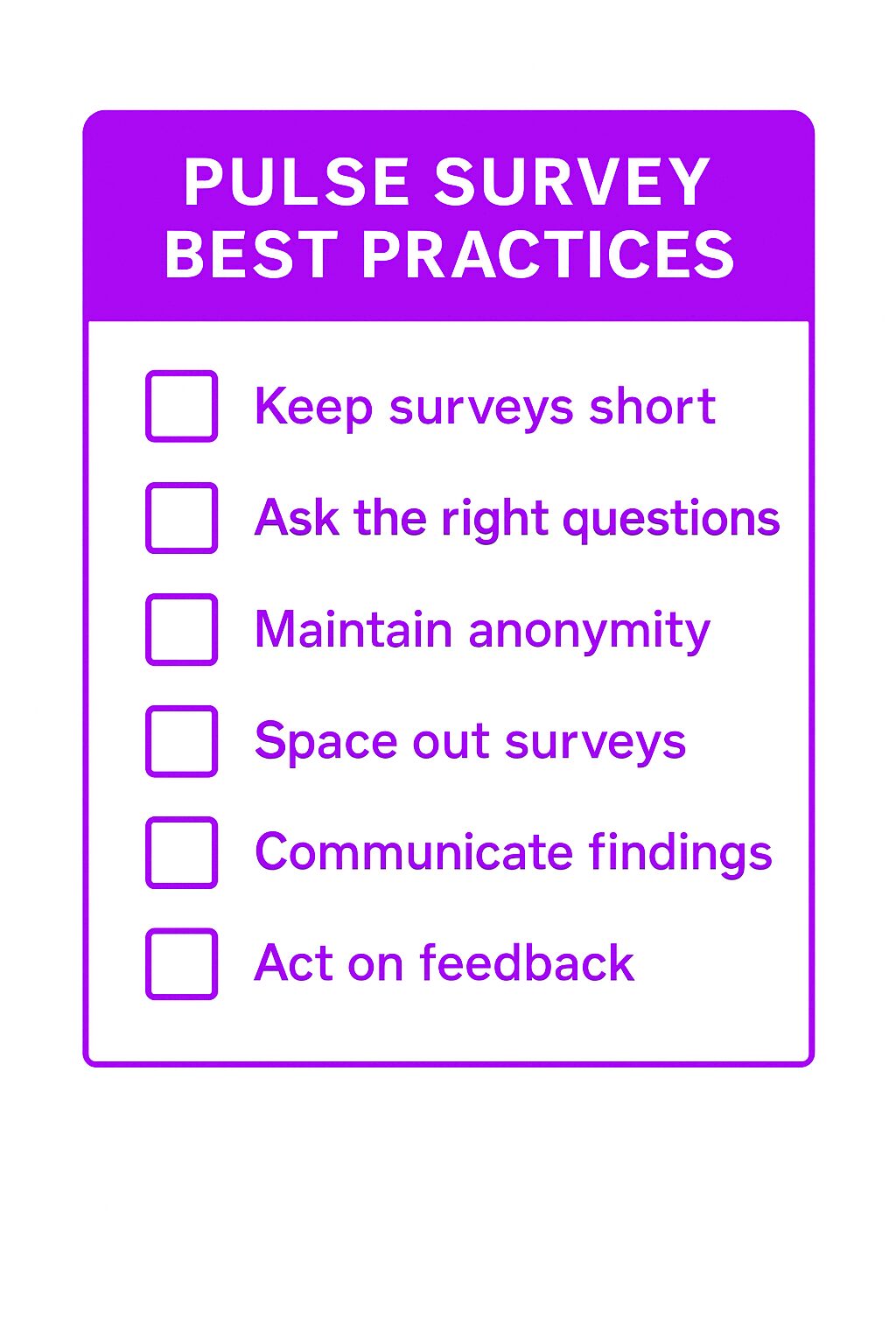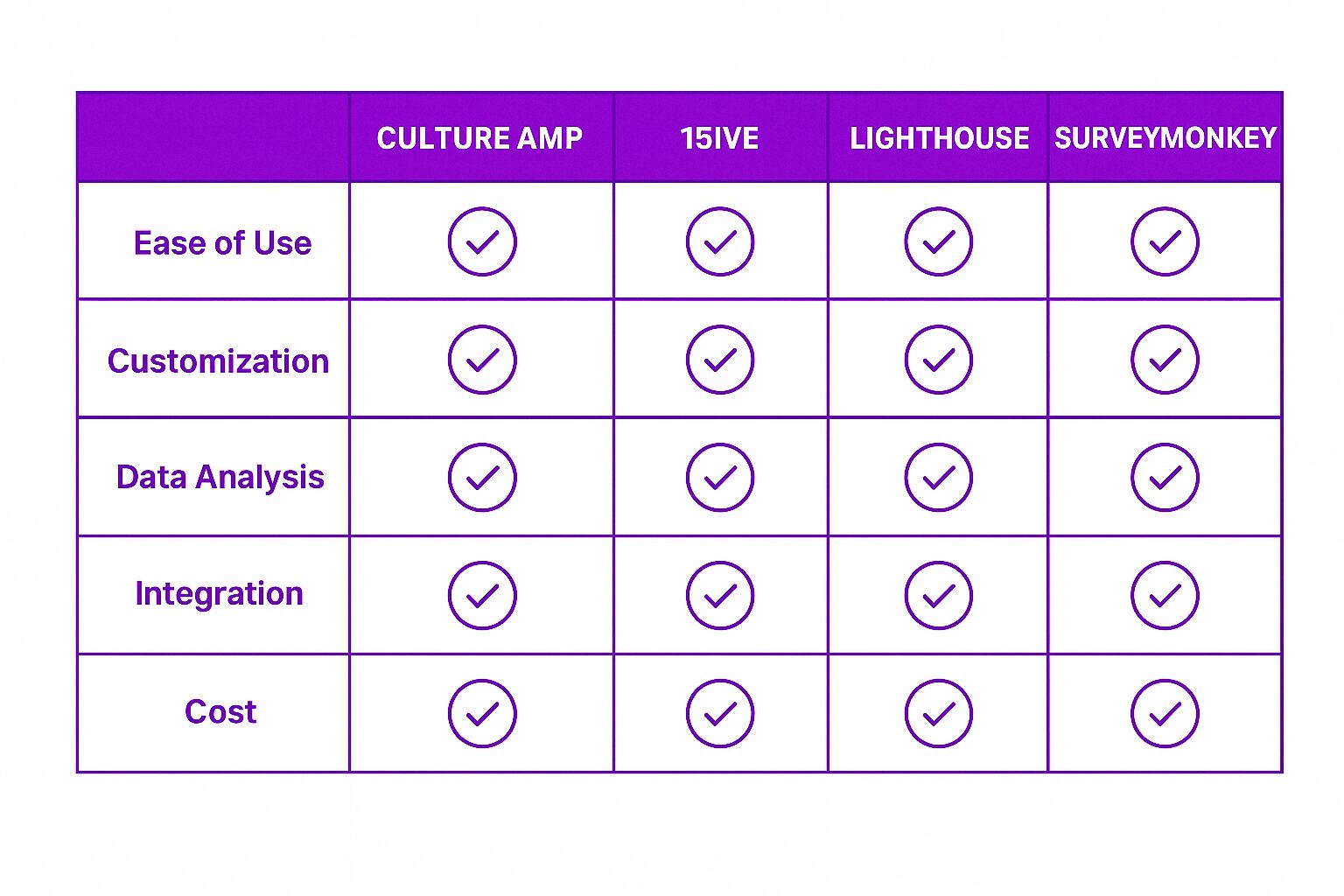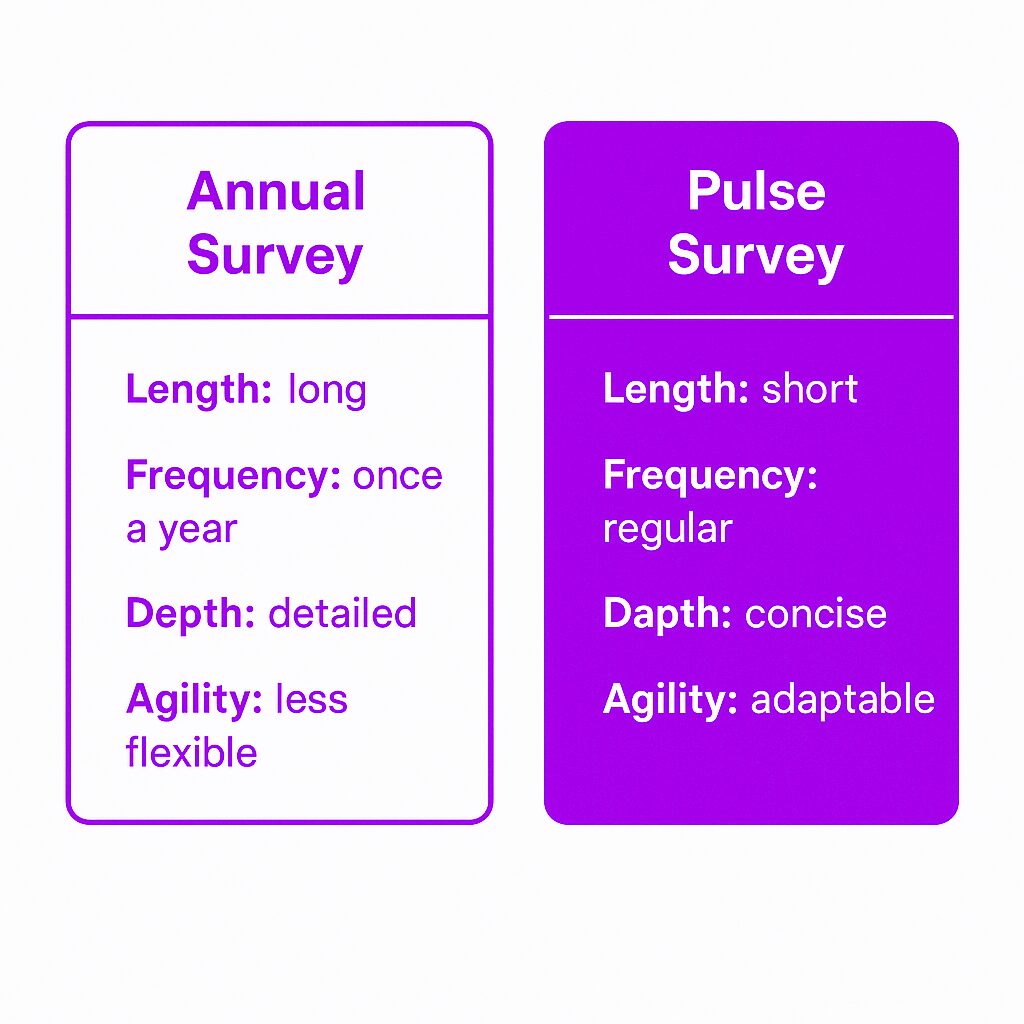What is an Employee Pulse Survey?
An employee pulse survey is a short, frequent questionnaire used to measure employee sentiment, engagement, and satisfaction in real time. Unlike traditional annual engagement surveys, pulse surveys are designed to be quick and easy to complete, providing organizations with continuous feedback from employees.
Pulse surveys help employers gauge morale, identify workplace concerns, and track engagement trends over time. By keeping surveys short and focused, companies can collect actionable insights without overwhelming employees with lengthy questionnaires.
Why Employee Pulse Surveys Matter
Organizations use pulse surveys to maintain a clear understanding of how employees feel about their work environment. These surveys act as an early warning system to rapidly identify potential issues within the workforce, allowing companies to address concerns before they become major issues and reinforce positive practices that contribute to employee satisfaction.
Companies with highly engaged employees experience better productivity, lower turnover, and improved workplace culture. Pulse surveys provide a structured way to check in regularly, ensuring that employee concerns don’t go unnoticed.
Key Components of an Employee Pulse Survey
Survey Design
A well-structured pulse survey includes concise, relevant questions that focus on employee experience, job satisfaction, and workplace culture. Employee feedback is crucial in designing effective pulse survey questions, as it provides real-time insights into employee sentiment and engagement levels. Questions should be clear and easy to understand.
Common topics covered include:
-
Job satisfaction
-
Workload balance
-
Leadership effectiveness
-
Team collaboration
-
Career development opportunities
Distribution Methods
Organizations can distribute pulse surveys through various channels, including:
-
Email
-
HR software
-
Mobile apps
Automated scheduling ensures surveys reach employees at regular intervals without manual intervention.
Data Collection and Analysis
Responses are typically collected and analyzed through survey software that provides real-time data visualization. By tracking trends over time, organizations can spot patterns and make informed decisions to improve workplace satisfaction.
Action Planning
Collecting feedback is only useful if action is taken. Employee surveys, particularly pulse surveys, create a continuous feedback loop for ongoing improvements. After analyzing the data, leadership should communicate findings, acknowledge employee concerns, and implement changes where necessary. Following up on survey results builds trust and encourages continued participation.
Creating and Implementing Employee Pulse Surveys
Creating and implementing employee pulse surveys is a crucial step in gathering relevant feedback from employees and driving meaningful change within an organization. To create an effective employee pulse survey, it’s essential to define the purpose and goals of the survey, identify the target audience, and determine the frequency of the surveys.
When implementing employee pulse surveys, it’s crucial to communicate the purpose and goals of the survey to employees, ensure anonymity and confidentiality, and provide a user-friendly survey platform. Additionally, it’s essential to analyze and act on the survey results, provide feedback to employees, and continuously monitor and evaluate the effectiveness of the surveys.
Some best practices for creating and implementing employee pulse surveys include:
-
Keeping the survey short and concise, with 5-15 questions
-
Using a mix of multiple-choice and open-ended questions
-
Including core engagement questions to track engagement levels over time
-
Using action-oriented questions to understand if employees see action being taken due to previous survey participation
-
Formatting the survey to provide a reliable and repeated measure for seeing overall trends in engagement and understanding action planning
Benefits of Employee Pulse Surveys
Real-Time Insights
Pulse surveys, as part of a structured engagement survey process, allow companies to measure engagement levels more frequently than traditional surveys, providing an ongoing understanding of employee morale.
Proactive Problem-Solving
By identifying concerns early, organizations can address issues before they lead to disengagement, turnover, or decreased productivity.
Enhanced Communication
These surveys create a two-way dialogue between employees and leadership, fostering transparency and a culture of continuous improvement.
Increased Employee Morale
When employees see that their feedback leads to meaningful change, they feel valued and more engaged in their work.
Challenges of Employee Pulse Surveys
Survey Fatigue
Frequent surveys can become repetitive and lead to lower participation rates. Organizations must strike a balance between gathering insights and respecting employees’ time.
Honest Participation
Employees may hesitate to provide honest feedback if they fear repercussions. Most employee pulse surveys are designed to be flexible and cost-effective, encouraging honest participation. Ensuring anonymity and emphasizing a culture of openness can help encourage candid responses.
Data Overload
Too much data without a clear analysis plan can be overwhelming. Organizations should focus on key metrics and actionable insights rather than collecting excessive information.
Lack of Follow-Through
If employees don’t see changes resulting from their feedback, they may disengage from future surveys. Organizations must demonstrate that survey results drive real improvements.
Best Practices for Conducting Pulse Surveys
Keep It Short
Limit surveys to a few key questions to maintain high participation rates.
Ask the Right Questions
Use a mix of quantitative and qualitative questions to capture both measurable data and open-ended feedback.
Maintain Anonymity
Allow employees to respond anonymously to encourage honest feedback.
Space Out Surveys Appropriately
Conduct surveys at a frequency that balances gathering insights with avoiding fatigue—typically monthly or quarterly.
Communicate Findings
Share results with employees and outline the actions the company will take based on feedback.
Act on Feedback
Implement changes based on survey insights and update employees on progress. Without visible action, participation rates may decline.
Pulse Survey Questions and Frequency
Pulse survey questions and frequency are critical components of an effective employee pulse survey strategy. When it comes to pulse survey questions, it’s essential to ask the right questions that will provide valuable insights into employee sentiment and engagement.
Some examples of pulse survey questions include:
-
I would recommend our organization as a great place to work
-
I feel a sense of belonging at this organization
-
I am excited about our organization’s future
-
Our organization has a great culture
-
Overall, I am satisfied with how decisions are made at this organization
When it comes to pulse survey frequency, it’s essential to strike a balance between gathering regular feedback and avoiding survey fatigue. Some best practices for pulse survey frequency include:
-
Conducting pulse surveys quarterly or bi-annually
-
Using a mix of short and long surveys to avoid survey fatigue
-
Providing regular feedback and recognition to employees
-
Continuously monitoring and evaluating the effectiveness of the surveys
Choosing the Right Employee Pulse Survey Tool
Choosing the right employee pulse survey tool is crucial for gathering relevant feedback from employees and driving meaningful change within an organization. When selecting an employee pulse survey tool, it’s essential to consider the following factors:
-
Ease of use and user experience
-
Customization options for survey questions and frequency
-
Data analysis and reporting capabilities
-
Integration with existing HR systems
-
Cost and scalability
Some popular employee pulse survey tools include:
-
Culture Amp
-
15Five
-
Lighthouse
-
SurveyMonkey
-
Google Forms
When choosing an employee pulse survey tool, it’s essential to consider the specific needs and goals of your organization, as well as the level of customization and support required. Additionally, it’s crucial to ensure that the tool is user-friendly, scalable, and provides valuable insights into employee sentiment and engagement.
Related Concepts
Annual Employee Engagement Surveys vs. Pulse Surveys
Annual engagement surveys provide in-depth analysis but lack the agility of pulse surveys. Pulse surveys offer more immediate insights, allowing for quicker adjustments to workplace policies and culture.
360-Degree Feedback
This method gathers feedback from multiple sources, including peers, managers, and direct reports. While pulse surveys focus on overall sentiment, 360-degree feedback provides a more detailed evaluation of individual performance.
Employee Net Promoter Score (eNPS)
Pulse surveys can include eNPS questions to measure how likely employees are to recommend their workplace to others. A high eNPS indicates strong engagement and satisfaction.
Real-World Use Cases
Tech Companies and Remote Work
Many tech firms use pulse surveys to measure employee engagement in remote work environments. Regular check-ins help assess productivity, collaboration challenges, and overall job satisfaction.
Hospitality Industry
Hotels and restaurants rely on pulse surveys to ensure staff remain motivated and feel supported in high-pressure environments.
Healthcare Organizations
Hospitals and medical facilities use pulse surveys to track employee well-being and job satisfaction, which directly impacts patient care.
Final Thoughts
Employee pulse surveys provide organizations with a valuable tool for maintaining engagement, improving communication, and fostering a positive workplace culture. By using these surveys effectively, companies can address concerns proactively, boost morale, and create a work environment where employees feel heard and valued.







